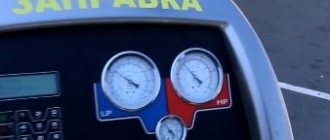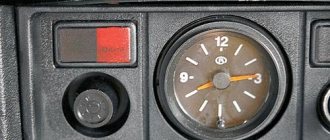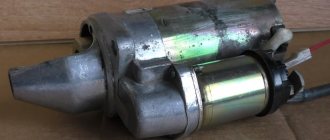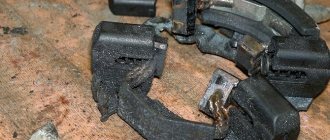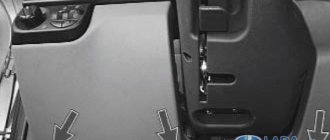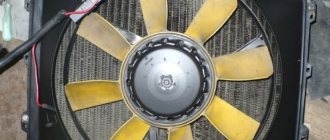Reasons for stove failure
If the heater on the “seven” does not turn on, then it is possible:
- The heater fan switch is faulty;
- the mounting block is faulty;
- speed control resistance;
- The heater motor is faulty.
Connection diagram for the VAZ 2107 stove
- mounting block;
- stove button;
- resistance;
- fan motor;
- egnition lock.
To carry out diagnostics, you need to make a test lamp (there are also factory-made ones) or it is best to have a tester (multimeter). The control lamp is a light bulb with wires, the ends of which end in probes.
Malfunction of the mounting block of the VAZ 2107 stove fuse
If the fan noise is not heard when the heater switch button is pressed, then the first thing to start examining is to check whether the VAZ 2107 F1 heater fuse is working (they are signed and marked on the cover) in the mounting block. In addition to the stove, it is responsible for the operation of the rear window defroster and reversing lights. In most cases, the serviceability of the fuse can be assessed by looking at it through the light, but sometimes it happens that it is simply not visible, in which case it is better to have a “control” or tester on hand.
Diagnostic devices
To check, connect one probe to the battery, touch the fuse with the second, and touch the free end of the fuse to the second terminal of the battery. If the fuse is good, the light will light up.
Follow the manufacturer's recommendations and install similar fuses, in this case 10 amps.
When F1 is operational during diagnostics, but there is no voltage on the blue-yellow wire of the switch, there is probably a break in the tracks in the mounting block itself. It can be repaired, but you will need tools and soldering skills, or you will have to replace it with a new one. Read more about the VAZ mounting block in the article.
Switch failure
After the fuse, we check the power button. Power from the unit comes to the yellow-blue wire, as already mentioned, and if there is voltage on it, then we check the heater switch.
We take a piece of wire, connect one end to the yellow-blue one and touch the other terminals one by one; if the motor starts working when both terminals are touched, then the switch is working. If the engine does not work in one of the positions, then a conclusion is made that the switch is faulty, but for an accurate assessment you need to check the resistance.
Connecting the VAZ 2107 stove button is shown in the photo.
If there is no voltage at both terminals, the VAZ 2107 heater button needs to be replaced. To do this, pry it up with a screwdriver and pull out the button. We take out the chips from the old button and connect the new one one by one.
Troubleshooting algorithm
If the electric cooling fan does not work on your VAZ 2107 (carburetor), you need to do the following:
- Turn off the engine and turn on the ignition.
- Use a flat-head screwdriver to short-circuit the terminals of the fan switch sensor. Please note that all control is based on mass. If the fan turns on, the sensor is faulty. If it doesn’t work, then the reason lies deeper.
- Disconnect the block from the electric fan and supply power from the battery directly. A rotating rotor indicates that the engine is running. If the electric fan does not work even this way, you will have to think about replacing it.
- If the fan and sensor are working properly, you need to check the electromagnetic relay (if present in the circuit).
- The wires are checked last. Oxidation very often occurs at the joints with the car body. And sometimes a banal break even happens.
The engine runs at one speed
In this case, it may be a malfunction of the button, a burnt-out resistance, or a motor malfunction (break of one winding). If the button is working properly, and the stove fan only works at high speed, then the first thing you need to check is the ballast resistance. It is checked in the same way as a fuse; if it breaks, measure it.
On the “seven”, you can only check it by removing the stove body, since it is located inside the body. In earlier models it is located under the dashboard in the middle, a little closer to the driver.
Heater motor malfunction
The main engine malfunctions are the rotor getting stuck in the bushings or bearings. With such a malfunction, the fuse usually burns out, so do not install a fuse with a high current, otherwise it will burn out the tracks of the block or wiring.
The second malfunction is wear of the brushes. In this case, when voltage is applied to any of the windings, the engine will not work.
To make sure that the engine is working properly, you need to check the wiring that goes to it, as the chips may simply have come loose or the negative wire has become disconnected.
Source
Main types of faults
The fan is necessary to cool the radiator at times when there is no oncoming air flow, that is, during slow movement or parking. With its help, a warm air flow from the radiator flows to the engine, which is important during winter warm-up.
READ How to Make a Subwoofer in Your Car with Your Hands
There are several options for incorrect operation of the VAZ-2107 electric fan:
- The device does not start under any conditions. In this case, the engine overheats. With this malfunction, it is important to look at the arrow indicating the temperature. If it reaches the red zone and the fan motor does not turn on, then the fault must be found in the power circuit or in the device itself. Most often the fan does not turn on due to:
- wear of brushes, commutator or armature winding of the electric motor;
- electrical circuit break;
- sensor malfunction;
- fuse blown;
- relay failure.
- Full time job. With this failure, the fan does not stop and spins up at any temperature. The following may cause a malfunction:
- sensor failure;
- closed Niva relay;
- short circuit of the power supply.
- Untimely switching on. This problem occurs when the temperature sensor readings are faulty. It transmits incorrect information to the relay, so it does not activate the device in time.
- Extraneous noise during operation. In the interior of the VAZ-2107, the moment the fan turns on is clearly audible. If this noise is accompanied by a creaking, hum or whistle, then you need to check the bearing or support sleeve of the cover. The appearance of a crackling or knocking sound is characteristic of contact of the impeller with the inner edge of the electric motor frame; this happens when the blades are deformed or misaligned.
If the fan is said to be not working, then most likely it does not start or does not work in a timely manner. Let's look at how to check the devices responsible for running it.
VAZ 2107 heater fan does not work
It is quite simple to understand that the heater fan on a VAZ 2107 does not work: you need to start the car and turn the switch responsible for the operation of the cabin heater. If the characteristic sounds from the fan operation do not appear, it means that the spare part needs to be repaired or replaced. Many owners of this car model face this problem. As a rule, you can find the cause of the breakdown and fix it yourself. It happens that the heater fan on a VAZ 2110 does not work only at some speeds. In this case, it is worth checking the functionality of the additional resistor or heating intensity toggle switch.
Reasons for fan failure
If the stove fan does not work on a VAZ 2107, you will have to check six elements that could have failed. Most often, this part stops functioning due to a blown fuse. This type of malfunction is considered the simplest, but it is quite problematic to fix. The fact is that replacing a blown fuse is not difficult: even a novice car enthusiast can cope with this task. However, the failure of the fuse is often caused by a short circuit, which is difficult to detect, because you will have to check the entire electrical circuit responsible for the operation of the car's interior heater. On the VAZ 2107, the fuse marked F7 is responsible for the operation of the stove. This element has a power of thirty amperes. If this fuse fails, you will notice that the glove compartment light and the cigarette lighter have stopped working along with the stove.
The fan on the VAZ 2107 may not work due to poor contact inside the mounting block. Such a malfunction quite often leads to the fan stopping functioning. To check whether the oxidized contacts in the mounting block are the cause of the malfunction, we take the block with the wires with our hand and move it. If the fan starts working, then you will have to remove the wiring harnesses and clean the contacts. A stuck relay in the ignition system also leads to fan failure. It is not difficult to detect such a breakdown. If the owner of a VAZ 2107 notices that the stove starts working only after the engine has warmed up, then the reason must be looked for in the ignition relay. This problem can only be eliminated by replacing the relay, which is located under the dashboard.
In some cases, the fan on the VAZ 2107 does not work only at certain speeds. In this case, you should make sure that the additional resistor has not failed. It is important to remember that at the first and second speeds, voltage is supplied to the fan through a resistor, and when the third speed mode is turned on, the current flows directly. In the event of such a breakdown, you simply need to replace the additional resistor responsible for the functioning of the car heater. A malfunction of the heater switch also leads to the fan not working on the VAZ 2107. To check this element, you will have to remove the center console, turn on the ignition and short-circuit the negative wire of the control light on the body. In this case, with the second wire we touch alternately the first, second and third contacts on the additional resistor. If the lamp is on, it means the switch is in working condition. Otherwise, connect the control wire to the positive terminal of the switch. If after this the lamp does not light up, you will have to look for a blown fuse or an open circuit.
Another reason for a non-working fan on a VAZ 2107 is the failure of the electric motor. The fan motor could have burned out or the brushes may have simply become stuck.
Examination
On VAZ 2109 engines, the operating temperature is 90 degrees.
If the indicator needle crosses the 100 degree mark, the car should be stopped immediately, the engine should be turned off and the power unit should cool down. Without doing this, you risk major, expensive engine repairs.
The motor can overheat for various reasons:
- The thermostat has failed;
- The radiator is clogged;
- The radiator fan has failed;
- The fan switch sensor is broken;
- The coolant level in the system has dropped;
- The pump has failed;
- The integrity of the wiring in the fan circuit has been compromised.
All these reasons can and should be checked before purchasing new parts.
Here is an example of checking a fan and sensor.
Take one wire about a meter long. Preferably with two crocodiles at the ends. The mass goes to the fan. Your task is to supply voltage directly from the battery to the fan. Apply 12 volts to the second contact of the fan. If he's spinning, he's fine. If not, you'll have to change it
Turning on the ignition, close the sensor contacts with a screwdriver. Normally, when it is closed, the fan should start spinning, and if it is open, it should stop. Please note that different types of sensors have a certain response temperature - from 87 to 90 degrees or more
Replacing the sensor
- Turn off the ignition;
- Drain the coolant from the expansion tank;
- Disconnect a pair of wires from the sensor terminal block;
- Using a 30 mm wrench, unscrew the regulator from its seat. You shouldn’t apply a lot of force; you risk breaking the seat;
- Following the reverse sequence, install the new sensor.
You can change the sensor without draining the coolant. To do this, you need to quickly unscrew the old regulator and screw in a new one in its place. A small part of the coolant will spill out, but you won’t have to drain it for a long time and then pour it back in.
Accurate check
In order not to rush to conclusions, experts first advise checking the sensor for functionality.
- If the fan does not want to turn on according to the standard circuit, try shorting the wires that go to the sensor. If the fan is running and the sensor is hot, the problem lies there. If the radiator is hot during testing, the sensor housing may be warm. This suggests that you should check the condition of the thermostat and the coolant level in the tank. You may need to change and top up accordingly.
- If, after closing the wires, the fan does not turn on, the sound of the relay being activated is not observed, check the condition of the relay and fuse. It is number 4 in the mounting block.
- By shorting the wires, the fan did not start, but the relay worked. Here you should check fuse number 8.
- If the fan starts randomly on a cold engine, it does not turn off for a long time, try disconnecting one wire from the sensor. If the fan stops, the sensor contacts are stuck. If the fan continues to turn, sticking has occurred on the contacts of the control relay.
Having discovered that the regulator has failed, there is nothing left to do but change the radiator fan activation sensor.
The fan of the VAZ 2107 stove does not work.
Hello. This time I will write about possible reasons why the heater motor on a VAZ 2107 may not work. These reasons can also be attributed to other classic models such as VAZ 2105, 2106, 2101, 2103, 2104.
To check all possible malfunctions, you need to have at least a test lamp, or better yet, a multimeter.
If you find out that it is the heater motor that has broken down, then read the article “Replacing the heater motor in a VAZ 2107.”
To understand what can break and why the VAZ 2107 heater fan may not spin, you need to consider the electrical circuit for powering this motor.
Fan
If the problem lies in the injector or carburetor cooling fan, then you will have to remove it. It is quite possible to repair the unit by replacing the electric motor or impeller.
Diagram with casing, radiator, fan and impeller
To remove the valve, perform the following operations:
- Disconnect the negative terminal from the battery;
- Disconnect the wire terminals. One of them is mounted on the fan casing;
- Take a wrench and unscrew a couple of connecting bolts. They fix the vent casing on the left tank;
- Next, unscrew another lower nut holding the device casing;
- Now you will need a socket extension to unscrew the right nut on top that secures the vent housing to the radiator;
- All that remains is to unscrew the fan pressure plate. To do this, remove the pair of left nuts;
- Remove the pressure plate by hand;
- Now remove the fan along with the casing.
READ How to connect the stove VAZ 2107
You have removed the unit. Now you have a choice - change the entire unit, or try to repair it by replacing the electric motor or impeller if they are damaged.
Connection diagram for the VAZ 2107 heater fan.
The diagram below shows how the stove fan (4) . Power from the battery, through the mounting block (1) , goes to the ignition switch (5) and again goes to the mounting block (1) . In the mounting block (1) it passes through fuse F1 (10 amperes) and goes to the stove speed switch button (2) . Next, power from the button goes either through resistance (3) to the motor (4) , or directly to the stove motor (4) .
The VAZ stove fan will not work if any of its circuit components is faulty. You can determine the reason why the VAZ 2107 heater fan does not work:
- There is a fault in the mounting block.
- The contacts of the heater fan speed switch are burnt out.
- The speed control resistance has burned out.
- There is a malfunction in the heater motor itself.
Let's take a closer look at each of the faults.
There is a malfunction in the VAZ 2107 mounting block.
If the stove stops blowing air, then first of all look to see if fuse F1 in the mounting block is intact. Usually, if this fuse blows, then the heated rear window and reverse lights stop working along with the heater. This fuse must be rated 10 amps . No more and no less. If you install a fuse of less than the nominal value, it will constantly burn out, and if you install a fuse of a higher nominal value, it is possible to burn the mounting block. If you have a fuse of a higher rating (as in the photo below), then the likelihood increases that the mounting block has failed and the plus is not supplied to the speed shift button. How to find out, read the next paragraph.
The contacts of the heater fan speed switch are burnt out.
You checked the fuse and saw that it was intact. Let's dig further. Now we take and remove the gear shift button from the panel and disconnect the wires from it. Afterwards, we reliably one end of the indicator light to ground, and alternately insert the other end into the removed terminals of the wires disconnected from the button. must be on !
If the light does not light up, then power is not supplied to the speed switch and the mounting block is most likely faulty.
If the light comes on when testing one of the contacts, it means either the button or something else is faulty. How to find out? Very simple! To do this, we make a jumper from a regular wire, from the contact, during the test of which the indicator light came on, to one of the other two contacts. The stove motor will work if the button is faulty. If the motor does not work, then it is the motor that is faulty.
The stove only works at one speed VAZ 2107.
When the stove operates only at the highest speed, this means that the ballast resistance has burned out.
In this case, just change it. It is located under the dashboard approximately in the middle, closer to the driver's side.
There is a malfunction in the heater motor itself.
Before disassembling the panel and stirring up the interior, check whether the mass going from the heater motor to the body sits well. It often happens that this wire simply rots.
If you have a multimeter, you can ring it. To do this, take out the speed switch button and disconnect the contacts from it. Now, in the continuity mode, connect one probe of the multimeter to ground, and check the wires with the others one by one. If the motor and ballast resistance are working properly, the multimeter will beep when checking two of the three wires. If the ballast resistance is faulty, then the multimeter will beep when checking one of the three wires, and if the heater motor does not work or does not have contact with ground, then the multimeter will be silent.
If you want to learn how to replace the stove motor, read this article!
I hope you found this article useful. If you have any questions or comments, leave them in the comments.
Source
Forced fan activation
Some owners of “classics”, including the VAZ 2107, install a forced fan button in their cars. It allows you to start the electric motor of the device regardless of the coolant temperature. Taking into account the fact that the design of the 7’s cooling system is far from ideal, this option could one day be of great help. It will also be useful for those drivers who often travel along country roads or are forced to stand in traffic jams.
Forced activation of the fan is appropriate only on carburetor cars. In cars with injection engines, it is better to rely on the electronic control unit and not make any changes to its operation.
Video: forcing the fan to turn on
The easiest way to make the fan turn on at the driver's request is to bring two wires from the contacts of the temperature sensor into the passenger compartment and connect them to a regular two-position button. To implement this idea, you only need wires, a button and electrical tape or heat shrink insulation.
If you want to “unload” the button from unnecessary loads, you can install a relay in the circuit according to the diagram below.
In principle, there is nothing complicated either in the design of the fan itself or in its connection circuit. So, in case of any breakdown, you can safely proceed to self-repair.
VAZ 2107 stove fan does not work reason
Failure of the stove motor on a classic is one of the common problems of the heating and ventilation system. But, more often than not, car enthusiasts are faced with the fact that the fan motor starts to whistle, squeak, and there is a hum and other strange sounds.
In these cases, it is possible to restore normal operation of the motor for a while. To do this, you should disassemble the engine, wash it from dirt, dust and lubricate the bushings and other rubbing parts with graphite lubricant. Litol-24 lubricant is suitable for bearings.
Note: the heater motor on bearings is more reliable and less noisy compared to a motor on bushings.
You should also make sure that the impeller does not touch the housing (casing). If necessary, sharpen the blades slightly.
Stove motor with impeller VAZ 2101-2107, Oka, Niva
Cooling fan malfunctions and their symptoms
Taking into account the fact that the fan is an electromechanical unit, the operation of which is ensured by a separate circuit, its malfunctions can manifest themselves in different ways:
- the device does not turn on at all;
- the electric motor starts but runs constantly;
- the fan starts working too early or too late;
- During operation of the unit, extraneous noise and vibration occur.
The fan doesn't turn on at all
The main danger posed by a broken cooling fan is overheating of the power plant. It is important to control the position of the arrow of the temperature indicator sensor and feel the moment the device turns on. If the electric motor does not turn on when the arrow reaches the red sector, most likely there is a malfunction of either the device itself or the elements of its circuit. Such breakdowns include:
- failure of the armature winding, wear of the brushes or commutator of the electric motor;
- sensor malfunction;
- break in the electrical circuit;
- fuse blown;
- relay failure.
Constant fan operation
It also happens that the device’s motor turns on regardless of the temperature of the power plant and runs constantly. In this case, the following may occur:
- short circuit in the fan electrical circuit;
- sensor failure;
- relay stuck in the on position.
The fan turns on early, or, conversely, late
Untimely turning on of the fan indicates that the characteristics of the sensor have changed for some reason, and its working element does not respond correctly to temperature changes. Similar symptoms are typical for both carburetor and injection “sevens”.
Extraneous noise and vibration
The operation of the cooling fan of any car is accompanied by a characteristic noise. It is created by the impeller, cutting the air with its blades. Even merging with the sound of the car’s engine, in the “seven” this noise is clearly audible even from the cabin. This is the norm for our cars.
If the rotation of the fan blades is accompanied by a hum, creaking or whistling, the front bearing or support sleeve in the cover may have become unusable. A cracking or knocking sound indicates contact of the impeller with the inner edge of the frame in which the electric motor is installed. This malfunction is possible due to deformation or misalignment of the fan blades. For the same reasons, vibration occurs.
What to do if the stove motor does not work (does not turn on, the blades do not spin)?
Possible causes of malfunctions and ways to eliminate them:
- The wires are damaged, oxidized or their tips are loose.
Crimp the terminals, strip the ends, replace faulty wires.
Clean the commutator or replace the motor.
Heater fan motor does not work at low speeds
- An additional resistor has burned out, its wires are damaged or their tips are not tightly attached.
Replace the resistor, crimp the terminals, strip the ends, replace faulty wires.
Heater fan motor armature rotates slowly
- The collector is dirty or oxidized.
Clean the commutator or replace the motor.
Replace the heater fan motor.
How much does a new heater motor cost?
Motors are usually sold assembled with or without an impeller. In the Moscow region (Moscow city and region), the price for a new heater motor on a bearing with an impeller for VAZ 2101-07, OKA, VAZ 2121 NIVA cars is about 500-600 rubles. Without an impeller - 100 rubles cheaper.
Characteristics of the stove fan electric motor:
- Nominal voltage 12 V
- Rated power 20 W
- Maximum current 5.0 A
- Rated speed 3000 min -1
- Weight 0.85 kg.
Used on the following cars: VAZ 2101. 2107, 2121 Niva, 1111 Oka.
A few more tips:
It is advisable to check the operation of the motor directly in the store. Be sure to keep your receipt after purchase.
There were even funny cases of selling defective products, when the stove motor turned in the opposite direction, and people complained about poor fan operation, and all the wires (ground and other terminals) were connected correctly.
The problem was that the assemblers at the factory had mixed up the wires by soldering them to other brushes. Therefore, nowadays you shouldn’t be surprised by anything, not even by a stove motor with a fan that blows in the other direction!
It is quite simple to understand that the heater fan on a VAZ 2107 does not work: you need to start the car and turn the switch responsible for the operation of the cabin heater. If the characteristic sounds from the fan operation do not appear, it means that the spare part needs to be repaired or replaced. Many owners of this car model face this problem. As a rule, you can find the cause of the breakdown and fix it yourself. It happens that the heater fan on a VAZ 2110 does not work only at some speeds. In this case, it is worth checking the functionality of the additional resistor or heating intensity toggle switch.
How the stove 2107 works
So, the heating system of the VAZ 2107 includes:
- heater;
- fan;
- heater control unit;
From the outside, air enters through the air intake into the casing of the air intake chamber. The camera is located in the engine compartment (in the area under the windshield). The air is then redirected to the heater, where moisture condensation occurs.
An important element is the heater radiator on the VAZ 2107, which heats up due to the circulation of coolant (coolant) in the engine cooling system. In this case, the air temperature changes due to the opening and closing of a special tap (VAZ heater tap), which reduces or increases the flow of heated coolant entering the heater radiator.
By the way, if the car is moving at high speed, the heating system can supply air to the cabin even when the VAZ 2107 heater fan is turned off. The fact is that the air flow from outside is capable of creating pressure in the air supply box, due to which heated air penetrates into the cabin.
The heating system itself is simple. Air ducts can direct heated air to the feet, the driver, the windshield and side windows, etc. You can control the stove, change the temperature, and select the blowing direction using the knobs on the dashboard.
The handle at the top is responsible for adjusting the position of the heater tap. By moving the handle as far as possible to the left, the tap closes completely, and to the right will mean full opening.
The middle handle changes the position of the air supply cover, which allows you to adjust the intensity of the hot air supply. The handle on the bottom allows you to control the dampers of the heated glass air ducts. If you move the handle to the right, the air flow goes to the side windows, while the left position allows you to blow the windshield.
Cooling fan VAZ 2107
In the power plants of the first "sevens" the radiator fan was installed directly on the water pump shaft. Like the pump, it was driven by a belt drive from the crankshaft pulley. This design was also used on other cars at that time. It almost never failed, and it was impossible to overheat the engine with it. However, she had one drawback. The constantly cooled power unit warmed up very slowly. That is why AvtoVAZ designers changed the principle of forced airflow, replacing the mechanical fan with an electric one, and with automatic activation.
Why do you need an electric fan?
The fan is designed for forced airflow of the cooling radiator. During operation of the power plant, liquid coolant enters the radiator through the opened thermostat. Passing through its tubes equipped with thin plates (lamellas), the refrigerant cools due to the heat exchange process.
When a car moves at speed, heat transfer is facilitated by the oncoming air flow, but if the car sits for a long time or drives slowly, the coolant does not have time to cool. At such moments, it is the electric fan that saves the engine from overheating.
Device design
The radiator fan consists of three main elements:
- DC motor;
- impellers;
- framework.
The electric motor rotor is equipped with a plastic impeller. It is she who, rotating, creates a directed air flow. The engine of the device is installed in a metal frame, with which it is attached to the radiator housing.
Modification of the VAZ 2107 stove: heater tuning
Although the design of the VAZ 2107 stove is simple, however, the design is not without drawbacks. For this reason, many owners modify the VAZ 2107 stove with their own hands or carry out repairs, change worn out elements, etc.
As a rule, the list of improvements includes improvements in terms of increasing the tightness of air ducts (often in those places where there are connections). This solution makes it possible to achieve more efficient heating of the interior space and blowing of the windows.
Replacing it with the VAZ 2108 version, which already has bearings, solves this problem too. To replace the VAZ 2107 stove fan, you need to prepare a fuse, a resistor and a speed switch. The parts fit from the Niva and Kalina models.
To remove the fan you need two screwdrivers (flat and Phillips), a 7 and 10 wrench, and pliers. To get to the fan, the instrument panel, shelf, and glove box are removed. Then, using key 7, loosen the casing of the air damper adjustment cable. Next, the cable loop is thrown off the lever.
Now, using key 10, the nut securing the heater body is unscrewed, after which the air ducts (left and right) are removed from the heater body with a flat screwdriver. Then, using the same flat screwdriver, you need to remove the latches that secure the fan.
Next you need to disconnect the wire terminals, remove the fan from the stove body, and remove the impeller. Taking into account the fact that the fan from the VAZ 2108 is slightly larger in size, changes are being made to the design of the stove.
Replacing only the motor requires making an additional hole in the grille through which hot air passes down. If you do not make a hole, the electric motor housing will rest against the grille.
The VAZ 2107 stove does not work: reasons
Taking into account the fact that there can be quite a lot of heater malfunctions, we will consider the main ones below:
- First of all, air in the cooling system causes the stove to not work. In this case, it is important to remove the air plug, that is, to perform high-quality de-airing of the engine cooling system.
- The heater may not work well because the radiator of the VAZ 2107 heater is clogged. As a result, the coolant does not circulate well through the heater system, and the air warms up poorly. It turns out that when the heater on a VAZ 2107 does not work completely, that is, it blows, but the air is cold, this often indicates that the radiator is completely clogged and needs to be washed or replaced. To quickly determine this, you need to feel the pipes. If the inlet pipe is warm and the outlet pipe is cold, then the problem is obvious.
- It also happens that the heater valve is open, but no coolant is supplied to the radiator. This usually happens because scale and dirt have accumulated in the system, and the tap is clogged. To solve the problem, the faucet must be removed for cleaning or replacement.
Repair of VAZ 2107 stove
First of all, it is important to immediately identify the breakdown. If the problem is a leaking pipe, faucet or air lock, this problem can be solved quickly.
If the cause is the heater radiator or other hard-to-reach elements, then a larger amount of work is expected, that is, you need to separately study the instructions on how to remove the VAZ 2107 heater and how to replace the VAZ 2107 heater. Let's look at methods for eliminating common faults.
- If the problem is with the faucet, it is optimal to immediately replace it with a new one. To do this, a pipe is disconnected under the hood that goes to the tap. To prevent some of the coolant from pouring into the engine compartment after removal, a container is placed under the pipe. Then the storage shelf is removed, then, using wrench 10, the nuts securing the faucet to the stove body are unscrewed. Now the tap can be removed from the studs and a new one installed.
As a rule, the heater tap needs to be changed if it gets stuck, etc. In this case, it is better to install a ceramic faucet instead of a standard metal one. Such a faucet, unlike its factory counterpart, does not become sour, scale does not accumulate on the ceramics, and corrosion does not occur. As a result, even if the tap is closed for a long time (for example, from spring to autumn), after opening it, full functionality remains.
- Radiator malfunctions are more serious failures. If the heater radiator is leaking or clogged, it must be removed. The same can be said about the stove fan, motor, etc. To carry out such repairs, you need to know how to remove the 2107 stove.
In short, to get to the radiator, you need to unscrew the radiator pipes. Taking into account the leaking antifreeze, you will need to replace the container. If you need to remove the stove fan, you do not need to touch the cooling system itself. In fact, removing the VAZ 2107 stove can be divided into two stages:
- dismantling elements in the cabin;
- removing elements under the hood;
Now, using a 10mm wrench, unscrew the 2 mounting bolts, remove the pipe from the radiator, and simultaneously dismantle the tap. Please note that there are rubber seals between the pipe and the radiator. So, they need to be replaced with new ones during reassembly.
If the radiator is clogged, flushing the stove radiator involves removing it, cleaning it from the outside, washing it from the inside, and blowing it with a compressor. The previously removed pipes, heater valve and other system elements are also cleaned.
The inside of the pipe can be cleaned with a brush. The radiator is washed out by Karcher under a pressure of about 5 atmospheres. You need to wash until clean water free of dirt and impurities flows out of the radiator.
If there is no Karcher, you can flush the radiator with caustic soda. It is enough to prepare a solution of soda, pour it into the radiator and leave for 60 minutes. Then the solution must be drained and the degree of contamination of the drained liquid must be assessed. The washing is repeated until the drained solution becomes clean. At the end, the stove radiator must be dried by blowing it with a compressor.
- As practice shows, the VAZ 2107 stove heats poorly not only due to leaks or problems with the radiator or tap. You can also highlight malfunctions in the operation of the fan mode switch, failure of the wiring of the control unit, oxidation of contacts, etc. For example, the motor of the VAZ 2107 stove may be problematic. As mentioned above, if a whistle appears, then the electric motor needs to be cleaned and lubricated (a temporary solution) or replaced with a new one, and it is better to install a more reliable option with bearings.
Let's move on. The control unit for the VAZ 2107 stove is controlled by levers on the instrument panel, which are connected to the actuators using flexible rods. Moreover, it is thanks to this solution that the degree of opening of the air dampers is regulated, the heater valve opens and closes, air flows are redistributed and blowing zones are selected.
There is also a lower damper called the air distribution cover. This damper is controlled by a special lever, which is located on the driver's side under the dashboard.
So, the rods mentioned above are a metal wire, which over time can stretch, burst, jump off, etc. It is not difficult to guess that broken heater cables and other problems with the dampers also cause the heater to not work correctly. In this case, the stove also needs to be disassembled and repaired.
How to remove/install a new sensor
After purchasing and checking the controller, you need to do the following:
- Disconnect the negative terminal from the battery;
- Remove the cover of the cooling distribution tank and the cap from the radiator;
- We substitute the container, turn off the tap on the radiator and drain the antifreeze;
- Having removed the wires from the sensor, use a 30mm wrench to unscrew the sensor by the large brass nut;
- Next, the sensor is removed. Be careful not to drop the copper O-ring on the sensor.
After this, the sensor is replaced with a new one. When installing, do not forget to coat the contact areas of the sensor and radiator with a layer of high-temperature sealant before screwing the sensor. This must be done dry. This scheme of action allows you to avoid leakage of antifreeze.
- Now you need to tighten the cap on the radiator, fill in the collected antifreeze, and, by connecting the negative terminal to the battery, check the operation of the sensor and fan. Do not forget to push through the air pockets in the cooling lines of the VAZ 2107.
READ Replacement Headlights Hyundai Accent
That's it, you can hit the road! The fan will run.
